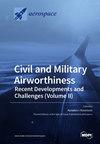Hybrid Adaptive Control for Tiltrotor Aircraft Flight Control Law Reconfiguration
IF 2.2
3区 工程技术
Q2 ENGINEERING, AEROSPACE
引用次数: 0
Abstract
Tiltrotor aircrafts have both fixed-wing control surfaces and helicopter rotors for attitude control. The redundancy of control surfaces provides the possibility for the control system to reconfigure the control law when actuator faults occur during flight. Possible actuator faults have been classified into two categories: predictable and unpredictable faults, and a different strategy has been adopted to deal with each kind of fault. Firstly, the predictable faults are handled by a multiple-model switching adaptive scheme. These kinds of faults are modeled, and their corresponding controllers are derived offline. Secondly, since the degree of drop in aerodynamic effectiveness cannot be predicted a priori, unpredictable faults are handled by a simple adaptive control scheme, to force the plant with faults to track the prescribed reference model. The presented methodology has been verified by nonlinear full-envelope flight simulation for both categories of actuator faults. The predictable fault is represented by the elevator floating. Elevator damage causing an aerodynamic effectiveness drop by 80% is chosen as the example of unpredictable fault. Both faults are simulated at the late stage of the tiltrotor conversion mode. Results show that the presented strategy of reconfiguration is able to detect the fault rapidly and stabilize the aircraft when a fault occurs, while the aircraft motion diverges without the reconfiguration scheme. The aircraft also presents a relatively good performance under controller reconfiguration with a well-tracked conversion path.倾转翼飞机飞行控制规律重构的混合自适应控制
倾转翼飞机既有固定翼控制面,又有直升机旋翼进行姿态控制。控制面的冗余性为控制系统在飞行过程中执行器出现故障时重新配置控制法则提供了可能。可能出现的作动器故障被分为两类:可预测故障和不可预测故障,每类故障都采取了不同的处理策略。首先,采用多模型切换自适应方案处理可预测故障。对这些故障进行建模,并离线推导出相应的控制器。其次,由于无法事先预测空气动力效率下降的程度,因此采用简单的自适应控制方案来处理不可预测的故障,以迫使出现故障的工厂跟踪规定的参考模型。针对两类作动器故障的非线性全包络飞行模拟验证了所提出的方法。可预测的故障以升降舵漂浮为代表。不可预测故障的例子是升降舵损坏导致气动效能下降 80%。这两种故障都是在倾转旋翼机转换模式的后期进行模拟的。结果表明,所提出的重新配置策略能够迅速检测到故障,并在故障发生时稳定飞机,而在没有重新配置方案的情况下,飞机运动会出现偏差。在控制器重新配置的情况下,飞机的性能也相对较好,转换路径跟踪良好。
本文章由计算机程序翻译,如有差异,请以英文原文为准。
求助全文
约1分钟内获得全文
求助全文
来源期刊

Aerospace
ENGINEERING, AEROSPACE-
CiteScore
3.40
自引率
23.10%
发文量
661
审稿时长
6 weeks
期刊介绍:
Aerospace is a multidisciplinary science inviting submissions on, but not limited to, the following subject areas: aerodynamics computational fluid dynamics fluid-structure interaction flight mechanics plasmas research instrumentation test facilities environment material science structural analysis thermophysics and heat transfer thermal-structure interaction aeroacoustics optics electromagnetism and radar propulsion power generation and conversion fuels and propellants combustion multidisciplinary design optimization software engineering data analysis signal and image processing artificial intelligence aerospace vehicles'' operation, control and maintenance risk and reliability human factors human-automation interaction airline operations and management air traffic management airport design meteorology space exploration multi-physics interaction.
 求助内容:
求助内容: 应助结果提醒方式:
应助结果提醒方式:


